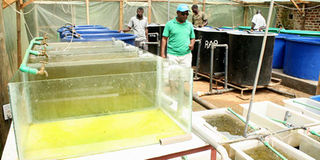Brief news on farming and agribusiness in the country

A fish farm in Kisumu. Experts note that to ensure that aquaculture students get employment opportunities it would be ideal to create awareness on need for people to embrace the culture of eating more fish. FILE PHOTO | NMG
What you need to know:
- Those involved in the programme are officials from Commission for University Education (CUE), Kenya Marine and Fisheries Research Institute (KMFRI), lecturers and researchers from Kenyan universities among others.
- According to KMFRI assistant director, Dr Betty Nyonje, the experts will come up with suitable courses that will meet the market demand.
- Mary Opiyo, a research scientist at KMFRI, said Kenyan institutions can offer different courses, depending on their location.
- Anne Mbaabu, Agra’s Head of Markets, pointed out that it is difficult to talk to farmers about growing the crop if there is no market.
Process to streamline fisheries training starts
Aquaculture and fisheries experts are working on streamlining training in the sector to harmonise what students and farmers learn.
This comes at a time when the sector is facing stiff competition from Chinese imports.
According to experts, with harmonised and specialised fisheries and aquaculture education, the country can have enough skilled workforce to participate in boosting both quality and quantity of fish produced.
To address the training gaps, the local experts have partnered with their counterparts from Belgium in analysing and coming up with recommendations on what Kenyan institutions of higher learning should teach in aquaculture studies.
The work is being implemented under a project dubbed 'Building a strategic framework for aquaculture education in Kenya'. The project is funded by the Flemish Inter-University Council, Belgium (VLIR-UOS).
Those involved in the programme are officials from Commission for University Education (CUE), Kenya Marine and Fisheries Research Institute (KMFRI), lecturers and researchers from Kenyan universities among others.
CUE deputy director in-charge of quality, audit and standards Prof Ann Nangulu said the experts will identify the gaps in aquaculture training and come up with suitable recommendations. The recommendations, she added, will inform policy in aquaculture education.
According to KMFRI assistant director, Dr Betty Nyonje, the experts will come up with suitable courses that will meet the market demand.
To ensure that aquaculture students get employment opportunities, she noted, it would be ideal to create awareness on need for people to embrace the culture of eating more fish.
Like other agriculture-related courses, many students shy away from studying aquaculture as they find it less appropriate for the white collar job market.
"Students need to view aquaculture studies as a biological science through which they can contribute towards the country's food security," said Prof Gilbert Van Stappen, an aquaculture scientist from Ghent University, Belgium.
Mary Opiyo, a research scientist at KMFRI, said Kenyan institutions can offer different courses, depending on their location.
Those at the Coast for example can teach studies marine aquaculture, while those in Central and Nyanza can offer cold water aquaculture and sustainable cage farming courses respectively.
Other 'modern' training opportunities include technologies in recirculating aquaculture and aquaponics farming.
-Rachel Kibui
****
Form groups to earn more, banana farmers told
For many years, banana farming in different parts of the country hasn’t been profitable particularly due to use of traditional varieties and lack of markets.
However, in areas where farmers have organised themselves into groups and adopted tissue cultured bananas, profit margins are going up, according to an impact assessment by researchers from the University of Nairobi and the University of Sydney.
Dr Shymal Showdhury, an economist at the University of Sydney, says that building a competitive industry involves registering farmers in groups, and building a strong market link to ensure that their produce goes to the market.
He added that the use of irrigation, fertiliser and high quality planting materials are crucial in enhancing production at the farm level.
“An average Kenyan farmer produces a tonne of bananas per hectare while an Indian farmer 30 tonnes,” he noted.
It is estimated that there are about 390,000 smallholder banana farmers in the country and 84 per cent of them own less than 0.2 hectares.
But the government and the Alliance for a Green Revolution in Africa (Agra) have been promoting modern technology adoption among banana growers.
Anne Mbaabu, Agra’s Head of Markets, pointed out that it is difficult to talk to farmers about growing the crop if there is no market.
“Market is one of the biggest challenges and this is one of the areas we started off with in a programme called East Africa Market Development Associates.
-Leopold Obi





